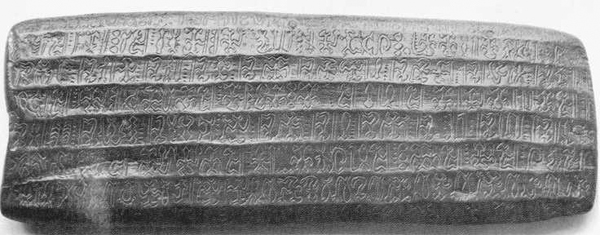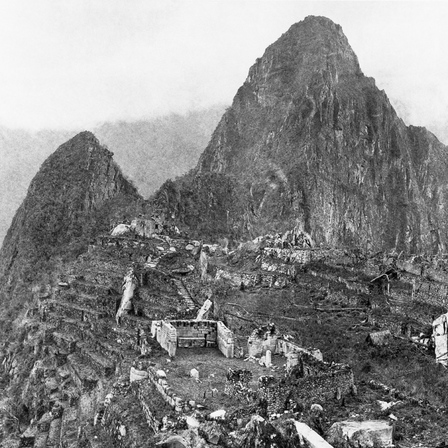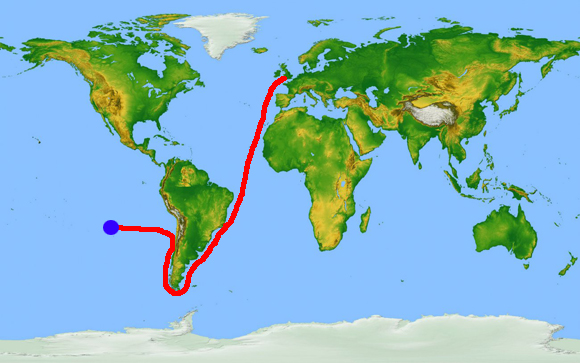 | |
| Light show for anniversary of the discovery of the famous "Lost City" (photo by Daily Mail) |
Today, July 25, marks the 100th anniversary of the discovery of the “Lost City” of Machu Picchu.
 |
| Indiana Jones (played by Harrison Ford) and Hiram Bingham |
Hiram Bingham III (1875-1956), historian, explorer, treasure hunter and politician “discovered” the city that the Incas had abandoned 400 years before and which the Spanish conquistadors were never able to find. (He was the inspiration behind Hollywood’s Indiana Jones character.) About 1,000 people were living there at the time.
Although other explorers had “found” Machu Picchu years before, Bingham was the first to scientifically explore and publicize the place that had been covered in an overgrowth of jungle trees and vines. The entire April 1913 issue of National Geographic was devoted to his work there. Bingham also wrote about it, notably Inca Land: Explorations in the Highlands of Peru (1922) and Lost City of the Incas, a 1948 best-seller.
 |
| Inca stone work |
Machu Picchu was revered as a sacred place at a time quite a bit before the Incas “adopted” it as their own. The five-square-mile complex of palaces, baths, temples, storage rooms and about 150 houses arranged around a central plaza was completely self-contained. It was surrounded by agricultural terraces and watered by natural springs that could accommodate the population that lived there. Here is an example of the stone cuttings that were fitted together without mortar. Their construction was well-suited for earthquakes because they could sustain tremors without collapsing.
"These structures, carved from the gray granite of the mountaintop, are wonders of both architectural and aesthetic genius. Many of the building blocks weigh 50 tons or more yet are so precisely sculpted and fitted together with such exactitude that the mortarless joints will not permit the insertion of even a think knife blade." Source: http://www.sacredsites.com/americas/peru/machu_picchu.html
"These structures, carved from the gray granite of the mountaintop, are wonders of both architectural and aesthetic genius. Many of the building blocks weigh 50 tons or more yet are so precisely sculpted and fitted together with such exactitude that the mortarless joints will not permit the insertion of even a think knife blade." Source: http://www.sacredsites.com/americas/peru/machu_picchu.html
There is great speculation about why the Incas built Machu Picchu. Some say it was an estate and retreat site for Pachacuti and his royal court to relax, hunt and entertain guests.
 |
| Statue of Pachacuti in Machupicchu Pueblo in Peru |
Pachacuti Inca Yupanqui (or Pachacutec) was the ninth Sapa Inca (1438-1471/1472) of the Kingdom of Cuzco, which he transformed into the Inca Empire called Tawantinsuyu. In less than a century the empire had grown from about 155,000 square miles in 1448, to 380,000 square miles in 1528, the year Pizarro and the Spanish conquistadors arrived. In Quechua, the language of the Incas, Pachakutiq means “He who shakes the Earth,” and Yupanqui means "with honor". During his reign, Cuzco grew from a hamlet into the capital city of an empire that within three generations stretched from modern-day Ecuador to Chile (about the size of the eastern seaboard of the United States) and included Peru, Bolivia and northern Argentina. Pachacuti is considered a national hero in modern Peru. During the 2000 Presidential elections, the mestizo Indian population gave candidate Alejandro Toledo the nickname Pachacuti.
Others speculate it was a nunnery or a training center for priestesses, although that theory has been debunked since skeletal remains there were half male and half female.
Bingham thought it was the birthplace of Inca society but that theory has since been disproved, too, when archaeologists determined that it was Espirtu Pampa, about 80 miles west of the Inca capital city of Cuzco. Actually, Bingham was looking for Vilcambamba la Vieja, the last stronghold of the Incas before the Spanish conquistadors took over, when he found Machu Picchu.
 |
| Intihuatana stone (meaning “Hitching Post of the Sun”) |
"At midday on March 21st and September 21st, the sun stands almost directly above the pillar, creating no shadow at all. For a moment the sun is 'tied' to the rock. At these periods, the Incas held ceremonies at the stone in which they 'tied the sun' to halt its northward movement in the sky. There is also an Intihuatana alignment with the December solstice (the summer solstice of the southern hemisphere), when at sunset the sun sinks behind Pumasillo (the Puma's claw), the most sacred mountain of the western Vilcabamba range, but the shrine itself is primarily equinoctial.”
"Shamanic legends tell that when a sensitive person touches their forehead to the Intihuatana stone it opens their vision to the spirit world. Intihuatana stones were the supremely sacred objects of the Inca people and were systematically searched for and destroyed by the Spaniards. When the Intihuatana stone was broken at an Inca shrine, the Inca believed that the deities of the place died or departed.
The Spaniards never found Machu Picchu, even though they suspected its existence, thus the Intihuatana stone and its resident spirits remain in their original position. The mountain top sanctuary fell into disuse and was abandoned some forty years after the Spanish took Cuzco in 1533. Supply lines linking the many Inca social centers were disrupted and the great empire came to an end.
Source: Sacred Sights.com
The Spaniards never found Machu Picchu, even though they suspected its existence, thus the Intihuatana stone and its resident spirits remain in their original position. The mountain top sanctuary fell into disuse and was abandoned some forty years after the Spanish took Cuzco in 1533. Supply lines linking the many Inca social centers were disrupted and the great empire came to an end.
Source: Sacred Sights.com
 |
| Manco Capac and his sister, Mama Occlo |
A 2009 study by Giulio Magli, an astrophysicist at the Polytechnic Institute in Milan, Italy, postulated that Machu Picchu was a pilgrimage site and a scaled-down version of a mythic landscape from the Inca religion. Worshipers could symbolically relive the harrowing journey of Manco Capac and his sister, Mama Occlo, who both rose out of Lake Titicaca to found a great city.
As legend has it, they were given a golden staff by the Sun, their father, who bade them settle permanently at whatever place the staff should sink into the earth. Through a series of adventures, geomantic resonances, and astronomical correspondences, the site of Cuzco was chosen. According to the most frequently told story, four brothers, Manco Capac, Ayar Anca, Ayar Cachi, and Ayar Uchu, and their four sisters, Mama Ocllo, Mama Huaco, Mama Cura (or Ipacura), and Mama Raua, lived at the Paccari-Tampu [tavern of the dawn], several miles distant from Cuzo. They gathered together the tribes of their locality, marched on the Cuzco Valley, and conquered the tribes living there. Manco Capac had by his sister-wife, Mama Ocllo, a son called Sinchi Roca (or Cinchi Roca). Authorities concede that the first Inca chief to be a historical figure was called Sinchi Roca (c. 1105-c. 1140). Thus the foundation for an empire was laid.
Source: Info Please
Source: Info Please
Machu Picchu sits 9,090 feet above sea level and 300 miles south of Lima. It is one of the most visited places in South America with 250,000 visitors per year. Four years ago it was voted one of the Seven Wonders of the World in a global Internet poll.
 |
| Machu Picchu in 1911 as Bingham found it |
After Bingham’s discovery, National Geographic magazine awarded him a $10,000 grant that was matched by Yale University where he was a professor of history and politics. This money afforded him three more expeditions to the site, which also led to the taking of 44,000 pieces and sparked a long-standing controversy between him, Yale, and Peruvians. This past March, 366 of those pieces were returned in time for the 100th anniversary celebration.
Seven hundred guests celebrated the anniversary on July 8 complete with a symphony orchestra, fireworks and a breathtaking light show. To read more and see photos of the celebration, see the Daily Mail story.
 |
| Machu Picchu today |
My Experience of Machu Picchu
I visited Machu Picchu in March 1986 as a W.K. Kellogg National Leadership Fellow. It was a memorable experience, mostly because I felt I touched the hand of God here and understood my smallness compared to the immensity of God’s creation. Here is an excerpt from my journal.
We arrived in Machu Picchu today and there are few words that can describe it.
We rode the train from Cuzco to Machu Picchu trekking through the Andes Mountains, which are full of terraced agricultural land. Sometimes we’d see Indian farmers working, sometimes a village of adobe-brick houses. The colors were greens of many hues from very different looking plants.
Once we arrived at the train station we were met by the ever-present vendors and it was there I bought my hat, bargaining for $2 down from $3.
 |
| The train follows the Urubamba River |
On the train we descended to the Sacred Valley of the Incas and followed the Urubamba River, which is white water with muddy rapids that are so strong that no one has been able to navigate them and live.
 |
| Hiram Bingham Highway, a series of switchbacks up the mountain |
When we arrived at Machu Picchu, we waited about half an hour to take the bus that climbed its way to the top of a mountain via switchbacks on the Hiram Bingham Highway. Here, we would find the Lost City—as well as our hotel.
On the way down from the mountain, young boys compete with the bus to see who can get to the bottom first—only they go straight down through the forested area. If they win, the tourists offer them a propina or tip, which usually amounts to about six cents.
The mountains are very pointed peaks that thrust themselves straight up into the sky. The clouds hover around the peaks and luckily for us, the sun was out. But these clouds move about, changing the face of the unbelievable sight before us. This is one small valley of the world but I feel dwarfed by their majesty and beauty. I also feel less focused on myself and instead part of a whole, incredible universe. I realize that, as a human being, I am certainly not in control of Nature, but a part of it--one small part of it.
As I walked among the ruins of Machu Picchu I wondered how the Incas managed to remain subservient to God and Nature, especially since they built this fantastic city as a kind of "co-Creator" with God. Most all of the rocks to build the city were cut from the surrounding mountains but in several places the structures were worked in the existing mountain. Machu Picchu is an example of God and man working together to create beauty--and a city both. When this co-creation occurs, a relationship emerges that promotes oneness with each other through oneness in the buildings. (Architecture reflects man’s view of his reality, according to Kenneth Clark in the PBS series, Civilization and Machu Picchu certainly illustrates this co-creation relationship between God and Man.) However, sometimes, in his hubris, Man forgets that he is a part of the world and not the Creator. That has led many times to the downfall of even the greatest of civilizations.
The Incas who built Machu Picchu must have been very reflective people and very much in touch with their environment and their relationship with the gods.
Not one of the Kellogg fellows has been unable to be in awe of our environment before us. I guess we really are made of clay feet and really do have the potential of being in unity with God/Earth when we experience places like this. We just seem to work so hard at controlling Nature—or commodifying it—that we often miss or forget its essence and beauty.
I am reminded of the Amish who believe it is necessary to view God’s great earthly wonders because it helps to see His power and glory. That's why they visit places like Niagara Falls.
Not one of the Kellogg fellows has been unable to be in awe of our environment before us. I guess we really are made of clay feet and really do have the potential of being in unity with God/Earth when we experience places like this. We just seem to work so hard at controlling Nature—or commodifying it—that we often miss or forget its essence and beauty.
I am reminded of the Amish who believe it is necessary to view God’s great earthly wonders because it helps to see His power and glory. That's why they visit places like Niagara Falls.
The uplift of these mountains is tremendous—it goes straight up. If you consider that the land was relatively horizontal and then uplifted into mountains, there must have been incredible change--and noise. Geologically speaking, this area is a wonder.
Machu Picchu is the second oldest civilization that I have visited during the fellowship. The first was Mexico City, the land of the Aztecs. Walking among ruins of a once-great civilization affects me. I try to imagine life here, but more importantly, I realize I'm walking the same trails that others before me walked--and I don't mean the tourists. In this way I feel connected to history and to a people who created a great civilization. What incredible people they must have been to build cities like this.
Our archeologist speaker at night said that the Incas are the Greeks of the Americas and should be regarded as such. He estimated he is six percent Inca and he seemed very proud of it. This pride was something the fellows would experience a lot as we got to know our speakers and guides.
Our archeologist speaker at night said that the Incas are the Greeks of the Americas and should be regarded as such. He estimated he is six percent Inca and he seemed very proud of it. This pride was something the fellows would experience a lot as we got to know our speakers and guides.

